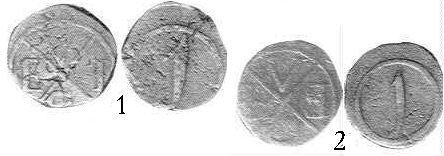
|
Events
News
Members
articles
Publications Book reviews Site search Internet Membership About ONS |

|
|
ONS Newsletters 159
The first copper coins struck by the East India Company for Bengal are of
considerable rarity, so it is a pleasure to be able to publish two
specimens that recently turned up in Calcutta1. As noted by Fred
Pridmore2,
these pieces were first struck in 1757, in order to provide small change to
pay the labourers employed in the building of Fort William. In an order
dated 24th October 1757, Mr Frankland was instructed to strike a number of
copper tickets of various values for this purpose. The only denomination
specifically referred to in the early documents is the anna, but it was
implied that other smaller denominations were also struck. In April 1760,
there were complaints that the copper tickets were not being accepted in the
bazar for the full value at which the Company paid them out, and an order
was then issued that they should be accepted at 54 pans of Cowries or 1
rupee for 16 copper annas. 
The appearance of these two new specimens in Calcutta, supports the attribution to Bengal, and the fact that they are struck with different dies and are different in diameter from the previously recorded example, indicates that the issue must have been reasonably substantial, and that they were issued in more than one batch. Their rarity can presumably be explained because copper was not generally accepted as coinage in Bengal, so that the coolies who received them as payment, and the money changers or other traders, who accepted them as payment for goods or converted them into cowrie shells, would have redeemed them with the Company as soon as possible, rather than risk demonetisation. Also, it is likely that pieces of this original type were withdrawn from circulation when the new type of 1763-4 was issued, and they may have been demonetised either then, or later in the century when further efforts were made to introduce copper coins throughout Bengal. 1. My thanks to the late Partha Banerji for allowing me to publish these two specimens. 2. The Coins of the British Commonwealth of Nations, Part 4 India, Vol.1: East India Company Presidency Series c.1642-1835, Spink & Son, London 1975, pp. 198 & 244 |
||
 | ||
| ons@onsnumis.org | © 1999-2024 ONS | |